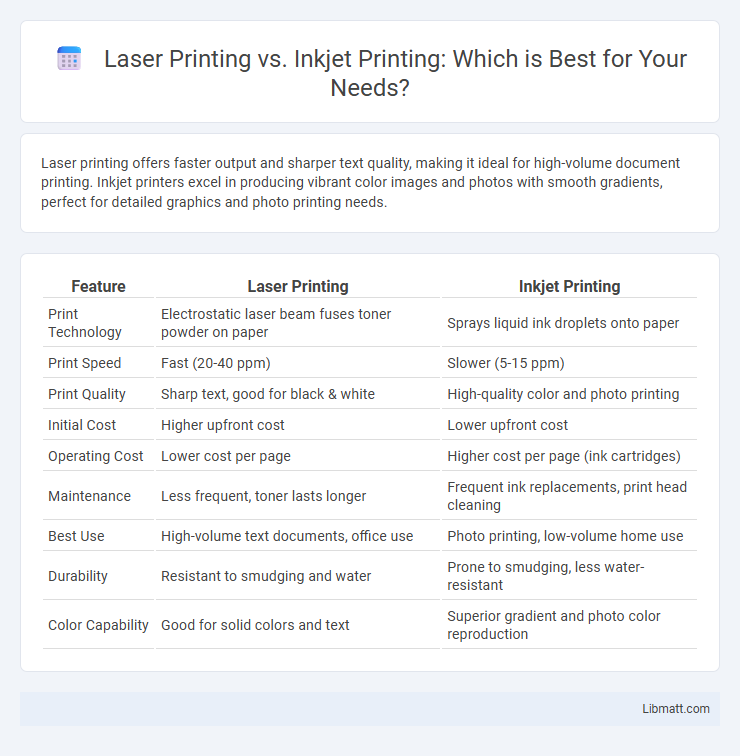Laser printing offers faster output and sharper text quality, making it ideal for high-volume document printing. Inkjet printers excel in producing vibrant color images and photos with smooth gradients, perfect for detailed graphics and photo printing needs.
Table of Comparison
| Feature | Laser Printing | Inkjet Printing |
|---|---|---|
| Print Technology | Electrostatic laser beam fuses toner powder on paper | Sprays liquid ink droplets onto paper |
| Print Speed | Fast (20-40 ppm) | Slower (5-15 ppm) |
| Print Quality | Sharp text, good for black & white | High-quality color and photo printing |
| Initial Cost | Higher upfront cost | Lower upfront cost |
| Operating Cost | Lower cost per page | Higher cost per page (ink cartridges) |
| Maintenance | Less frequent, toner lasts longer | Frequent ink replacements, print head cleaning |
| Best Use | High-volume text documents, office use | Photo printing, low-volume home use |
| Durability | Resistant to smudging and water | Prone to smudging, less water-resistant |
| Color Capability | Good for solid colors and text | Superior gradient and photo color reproduction |
Introduction to Laser and Inkjet Printing
Laser printing uses a focused laser beam to produce high-quality, precise text and graphics by transferring toner onto paper with heat. Inkjet printing sprays tiny droplets of ink directly onto the paper, ideal for vibrant color images and photo-quality prints. Your choice depends on printing volume, quality needs, and budget, with laser printers excelling in speed and text clarity while inkjets offer superior color reproduction.
How Laser Printers Work
Laser printers use a laser beam to produce an image on a photosensitive drum, which attracts toner particles corresponding to the image pattern. The toner is then transferred and fused onto the paper using heat and pressure, resulting in sharp, durable prints. Understanding how laser printers work can help you choose the best printer for high-volume, professional-quality documents.
How Inkjet Printers Work
Inkjet printers create images by propelling tiny droplets of liquid ink directly onto paper through microscopic nozzles, allowing for precise color blending and high-resolution output. The ink cartridges contain cyan, magenta, yellow, and black inks that combine to produce a wide color gamut suitable for photo printing. Thermal or piezoelectric technology controls the droplet size and placement, ensuring sharp text and vivid images ideal for home and photo printing needs.
Print Quality Comparison
Laser printers deliver sharper text and precise lines due to their toner-based technology, making them ideal for professional documents. Inkjet printers excel in producing vibrant color gradients and photo-quality images through fine liquid ink droplets. When comparing print quality, laser printers offer superior consistency for black-and-white text, while inkjets provide better color accuracy and detail for images.
Speed and Efficiency Differences
Laser printers offer significantly faster printing speeds compared to inkjet printers, producing high volumes of text documents quickly and efficiently, making them ideal for office environments. Inkjet printers, while slower, excel in high-quality color printing but may require frequent ink refills, potentially reducing overall efficiency. Your choice depends on whether speed or detailed color output is the priority for your printing needs.
Cost of Ownership Analysis
Laser printers typically have a higher upfront cost but lower cost per page due to efficient toner usage, making them more economical for high-volume printing. Inkjet printers generally feature a lower initial purchase price but higher ongoing ink expenses, resulting in increased total cost of ownership over time. Businesses with heavy printing demands benefit cost-effectively from laser technology, while occasional users may find inkjet printers sufficient for limited needs.
Suitability for Home vs Office Use
Laser printers excel in office environments due to their high-speed output and efficiency with large volumes, making them ideal for professional settings requiring crisp text and fast printing. Inkjet printers are more suitable for home use where photo-quality color printing and lower upfront costs are prioritized, though they typically have slower print speeds and higher ink replacement expenses. Your choice depends on print volume and quality needs, with laser favored for heavy-duty tasks and inkjet preferred for vibrant color images in smaller-scale use.
Maintenance and Durability
Laser printers offer lower maintenance needs and longer durability due to their robust toner cartridges that resist smudging and require less frequent replacement compared to inkjet cartridges. Inkjet printers demand more frequent maintenance like printhead cleaning to prevent clogging, which can affect print quality and longevity. Your best choice depends on balancing upfront costs with the printer's ability to handle extended use and ease of upkeep.
Environmental Impact
Laser printers generally consume more energy during operation due to their heating elements, while inkjet printers use less power but require more frequent cartridge replacements, contributing to higher plastic waste. The toner used in laser printers is a fine powder that can pose inhalation risks and is less biodegradable compared to the liquid ink in inkjet cartridges, which often contain water-based or pigment inks with a lower environmental footprint. Your choice between laser and inkjet printing can impact energy consumption, waste generation, and recyclability, making it essential to consider eco-friendly cartridge recycling programs and energy-efficient printer models.
Choosing the Right Printer for Your Needs
Laser printers excel in high-volume, fast printing with sharp text quality, making them ideal for offices and professional documents. Inkjet printers deliver superior color accuracy and photo printing, perfect for home use and creative projects. Selecting the right printer depends on your primary printing needs, budget, and frequency of use, ensuring optimal performance and cost-efficiency.
Laser vs Inkjet Printing Infographic

 libmatt.com
libmatt.com